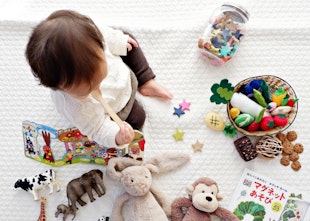Includes some safety tips to be aware of when planning tummy time
The most important aspect in the development of movement for babies is quite simply having the freedom to move!
There seems to be a tendency towards keeping babies in one place – quite often for safety reasons to keep an eye on them, we move our children from their car seat to the buggy, from their high chair to a walker. However, using these pieces of equipment for extended periods of time limits the amount of time babies have to enjoy free movement. All they really need is a mat on the floor on their tummies to wriggle and giggle.
Free movement begins with a baby spontaneously learning to stretch, reach out or roll over; they then break down the movement and work out what they need to do to make it happen and practice and repeat the process until it becomes natural. Allowing your baby the space and time to experience this is vital in supporting their development. Babies also spend so much time on their backs when they are sleeping that it’s important to give them the opportunity to have time on their tummies, which greatly increases their muscle strength and supports their physical development. The experience of being on their tummies helps babies learn to push up, roll over, crawl, sit up and pull themselves to standing.
Why Tummy Time?
Babies are active from birth and can start having a small amount of tummy time from as early as one month old. It’s a great way to encourage babies to get moving and build muscle strength; start by giving your baby just a couple of minutes on their front at a time, repeat this two or three times a day and gradually build up to a total of about an hour a day by around three months old. This hour shouldn't be all at once, but made up of short bursts across the day. Your baby will naturally try to lift their head to see what’s going on but won't be able to hold their head up for long periods of time until around three or four months old.
Wait until your baby is happy and alert and then place them on their tummy. This can be on a blanket on the floor, on your lap, or in your arms for younger babies. At first, your baby will be curled up and they'll put a lot of weight on their upper body and face but as your baby becomes more comfortable and secure in this position, they will begin to explore tentatively at first, and then with more confidence.
Some safety tips to be aware of when planning tummy time:
- Do not leave your baby alone during tummy time as they could get into a position that is dangerous or could bang their heads if they roll over
- Make sure your baby is placed on a hard surface such as the floor as your baby could roll off the sofa or a bed
- Don’t place your baby on their tummy after meals when they are full
- If you have other children or pets, make sure your baby is safely out of harm's way
- Ensure that there aren't any draughts and its warm on the floor
Some babies don't like being laid on the floor on their tummy initially as it’s a strange experience and it may be upsetting as they are used to spending so much time on their backs. For some, it may even be a little uncomfortable and if this is the case, place your baby onto their tummy for a minute or two and then turn them back or start by giving them tummy time in your arms in the rugby hold. Lay your baby on their tummy across your forearm and use your other arm to support them. Once your baby is used to being held in this way, start trying to re-introduce some tummy time on the floor. It can also help to prop your baby up on a rolled towel if they have some neck strength, giving them a new perspective on the world around them, and once your baby can get up on their forearms independently, the towel can be removed.
Laying on their front helps babies to strengthen their back and shoulders, as well as giving them a chance to move their arms and legs in a different way. This develops their gross motor skills and as they get older, they will push up from the tummy position with straight arms which is the precursor to crawling, strengthening the muscles babies need to get moving.
Make tummy time fun with rattle toys and plenty of face time with you. Eventually your baby will get used to being on their tummy and will enjoy this position and will wiggle and giggle whilst learning lots of new movements. Prop a colourful board book or place your baby’s toys around them on the floor and they will reach out for the bright and interesting objects such as rattles, cloth books or cuddly toys. Play with your baby on their stomach when they are awake and alert, and not hungry as they will enjoy interacting with you and will not be tired or fractious.
Remember we don’t need to teach babies how to move as they will respond to the opportunities provided in their environment and will teach themselves and learn from repetition of a movement. They will naturally want to explore and wriggle, touch and suck objects so encourage them safely to learn about the world around them whilst supporting their physical development.
Written by Dearbhala Cox Giffin- Early learning & development expert with Family Friendly HQ.
Dearbhala is Director of Childcare with Giraffe Childcare
Written by Dearbhala Cox Giffin- Early learning & development expert with Family Friendly HQ.
Dearbhala is Director of Childcare with Giraffe Childcare







